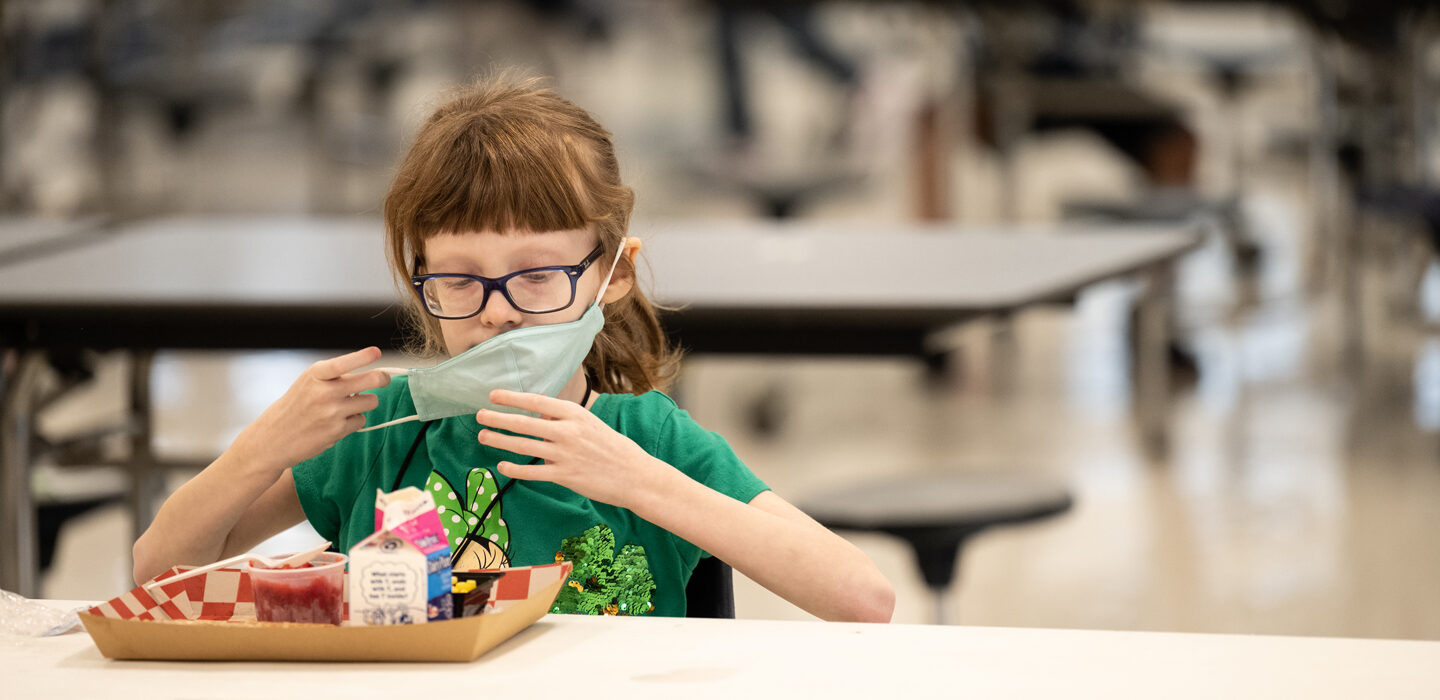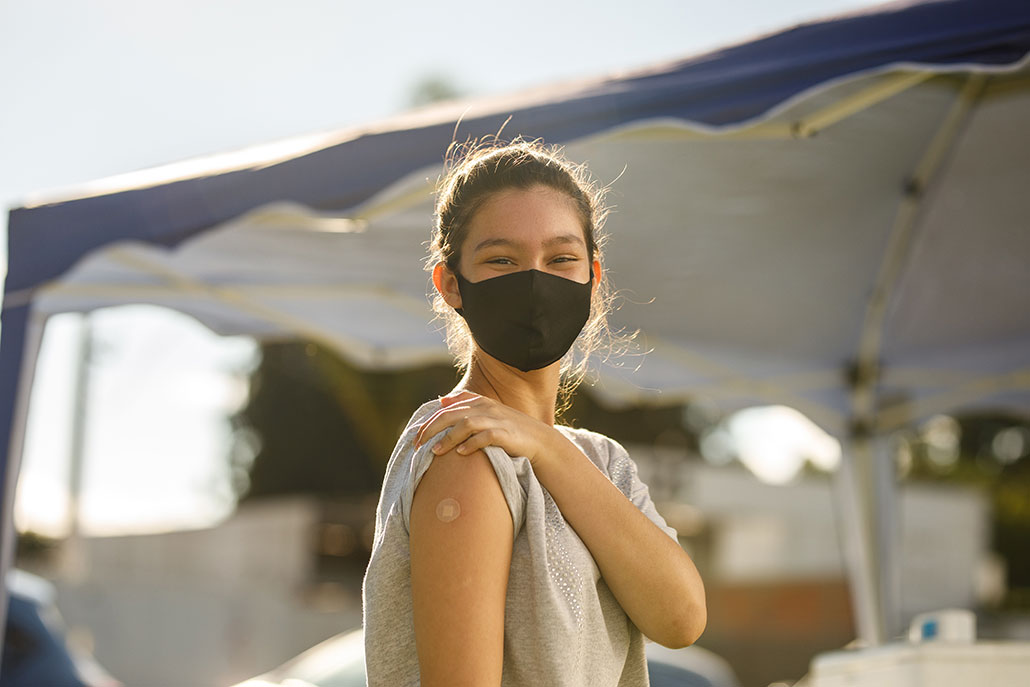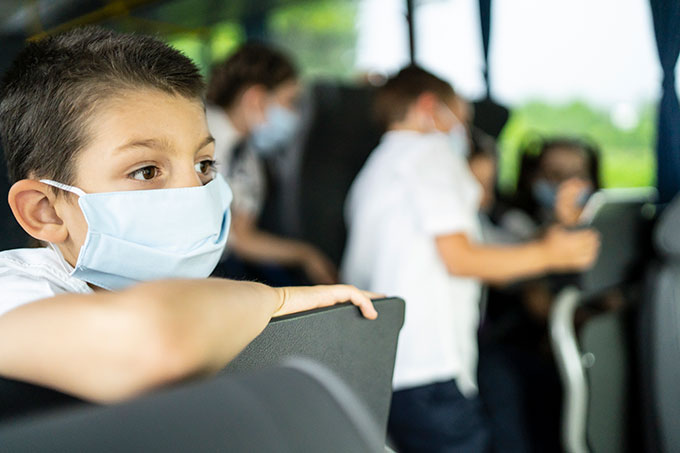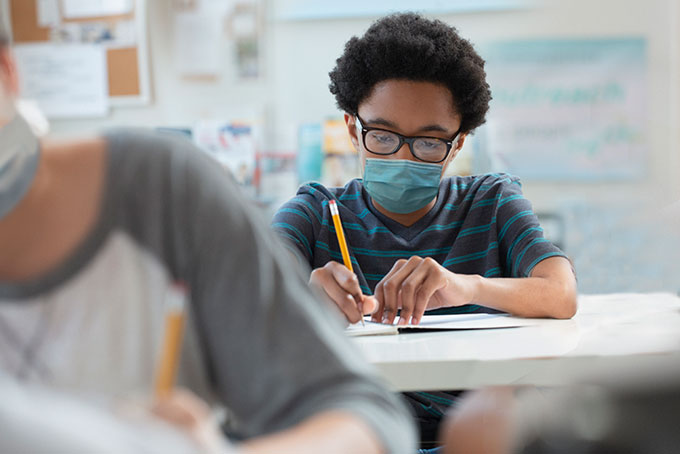Got back-to-school COVID-19 questions? We’ve got answers
Universal masking is key to staying safe and making the new school year go smoothly

Universal masking in schools is key to blocking transmission of COVID-19, research shows. This picture shows an elementary school student in Louisville, Ky., popping her mask back on after finishing her lunch.
Jon Cherry/Getty Images
By Sujata Gupta
School probably felt different for you last year. Maybe you stayed home, learning and hanging out with friends only through screens. Perhaps you went to class in person, masked and stayed six feet (1.8 meters) apart.
“Close contact” quarantines led many students to attend school off and on last year. If you had close contact with someone who tested positive, that meant getting tested yourself and staying home for seven days. Or if you didn’t get tested, you would typically wait 10 days until you could go back to school.
That complicated dance will likely continue this fall.
Adam Hersh is a medical doctor who studies infectious diseases in children. He works at the University of Utah in Salt Lake City. “Large numbers of students are going to be vulnerable to frequent quarantines,” he says. “That is going to be incredibly disruptive.”
Last fall, COVID-19 vaccines weren’t available. Now, from the age of 12 everyone in the United States can get vaccinated. But in some ways, opening schools this year may pose even more risks than last fall. The delta variant of the coronavirus is super contagious. It has become the dominant coronavirus strain across the United States.
Some medical experts predict an uptick of colds and other seasonal respiratory illnesses this year. Those illnesses have symptoms similar to those of COVID-19. That could mean even more missed school as you wait for the all-clear. And few states require protective masks, even for unvaccinated students. Several states have even banned school districts from issuing mask mandates.
As you return to school, you probably have questions. Here are answers to some common ones.

How can I stay safe from COVID-19 in the classroom?
Masks, masks and masks. That’s especially true for unvaccinated students, such as those under 12 years old. But vaccination rates are low for teenagers across the country, too. So masking is the best strategy for blocking COVID-19’s spread even for middle and high schoolers, Hersh says.
Masking is easy. And if everybody wears masks, other strategies aren’t needed as much, say Hersh and others. For instance, last fall, the U.S. Centers for Disease Control and Prevention (CDC) recommended children in school stay at least six feet (1.8 meters) apart. Newer evidence suggests less distancing, or even no distancing, is safe. But that’s only true as long as everyone wears a mask.
When everyone masks, “almost every new study that comes out looking at spacing has shown the three feet [0.9 meter] of spacing to be just as protective as the six feet [1.8 meters],” says John Bailey. He is an expert in domestic policy, the decisions governments make that affect their own citizens. He works at the American Enterprise Institute in Washington, D.C. The institute studies policies that impact education and other parts of people’s lives.
Even if you ride the bus, masking appears to be effective. Dana Ramirez is a pediatrician. This doctor works at Children’s Hospital of the King’s Daughters in Norfolk, Va. Last school year, she was part of a team that wanted to understand COVID-19’s spread on school buses. So they tracked nearly 1,200 students from August 24, 2020, to March 19, 2021. Those students, in grades one to 12, all attended a single, private local school.
Roughly 460 students rode the bus to school. Two masked students sat about 2.5 feet (0.75 meter) apart on each seat. Students were also tested regularly for COVID-19 — every two weeks at first, then weekly. That testing identified 39 students who rode the bus while infected. But masked students didn’t spread the virus to others on the bus. The researchers found zero cases of transmission among masked bus riders. Their findings appear July 20 in the Journal of School Health.

Scientists and medical doctors with the ABC Science Collaborative have been studying similar issues. The group collects data from schools in multiple states to inform educational leaders about best pandemic practices. Since July 2020, researchers have been tracking COVID-19 precautions and rates of transmission in North Carolina public schools. Their effort now includes 100 of North Carolina’s 150 school districts and more than a million staff and students.
In spring 2021, many kids were back in school in North Carolina. Some sat close together, less than three feet apart. Many classrooms didn’t have good ventilation. But universal masking was still effective in managing COVID-19’s spread. When everyone masked, the risk of an infected person spreading the coronavirus was less than 1 percent. That’s shared their finding in a June 30 report to lawmakers in North Carolina.
Masking works even in small classrooms. If “you have to cram 30 people into a really, really tiny room and much less than three feet apart, as long as everyone is masked, that’s cool,” says Kanecia Zimmerman. She is a leader of the ABC Science Collaborative. This pediatrician is also an epidemiologist at Duke University. That’s in Durham, N.C.
Besides masking, what else can schools do?
Schools should regularly screen all students for COVID-19, whether they have symptoms or not, says pediatrician Lynn Silver. She directs the Safely Opening Schools project and lives in Berkeley, Calif.
Silver is referring to rapid antigen tests. They deliver results in 15 minutes. From a swab in your nose, this test can detect molecules of the coronavirus. Children as young as age 3 or 4 can use these tests on themselves, Silver says. And school districts can get federal funding to pay for the tests.
Silver led a screening project from January to July 2021 across 10 school districts in five California counties. All the students wore masks. And they generally got tested once or twice per week. Schools gave almost 100,000 tests.
With regular tests, positive cases within schools stayed very low. Only 0.1 percent of more than 27,000 tests came back positive in the pilot study. Students who came back positive on these tests also underwent PCR tests. PCR tests are more accurate but take longer to process. PCR testing confirmed that there were few false positives from the rapid tests. The screenings also helped ease parents’ concerns. About 90 percent of parents said that the tests helped them feel more comfortable with in-person schooling.
“Screening is particularly valuable in elementary schools where all the kids are unvaccinated,” Silver says. And the tests are more effective at finding positive cases than symptom and temperature checks.
Still, this sort of regular screening takes a lot of work. For kids to be screened, their caregivers must give permission. Trained staffers are also needed to give the tests. Finally, screening takes time away from education, both Hersh and Zimmerman note.
“Screening becomes all the more important in a setting where masks are not going to be required or used at high rates,” Hersh says. But “I don’t think you could choose screening over masks and expect that you could keep the school environment safe.”
If everyone is wearing masks, do I need to stay home after “close contact” with someone who tests positive?
That’s ultimately a decision left to school districts and states. But the CDC offers guidance.
The agency defines a “close contact” as “someone who was within six feet of an infected person … for a cumulative of 15 minutes or more over a 24-hour period.” CDC currently recommends that close contacts who aren’t fully vaccinated should quarantine at home for seven to 14 days after exposure.
When a child or adult in a classroom tests positive, that can mean the entire class has to quarantine and get tested before returning to school. Zimmerman and her team found that a single positive case within a given school could trigger quarantines for more than 100 people.
But COVID-19 transmission in schools is very low when everyone wears masks. That’s something several studies this year have shown. So Zimmerman says the CDC should consider eliminating quarantine recommendations where everyone masks. That should help avoid unnecessary school absences. “My hope is the CDC will continue to move in the way of existing science,” she says.
Jennifer Dowd agrees. She is an epidemiologist and demographer, someone who studies health issues and population changes. She works at the University of Oxford in England. Without changes to quarantine recommendations, this school year could become very fragmented, she says.
That’s especially true in places where the option for remote classes is less available than in 2020. “It will be back like the old days when kids just missed school,” Dowd says, instead of being able to attend virtually.

What if masks are optional at my school?
The American Academy of Pediatrics recommends that everyone older than age 2 wears masks at school this fall. And in July, the CDC recommended that everyone in schools should wear a mask, even if they got a vaccine.
But the decision on masking in U.S. public schools has been left to the states. Less than a dozen states required masks as of early August 2021. In Florida, Texas, Arizona and a handful of other states, officials have expressly forbidden school districts from mandating masks in classrooms. That’s true even for children too young to be vaccinated.
That reality changes best practices entirely, says Zimmerman at Duke. Without universal masking, all the other COVID-19 precautions become essential. That includes six-foot distancing and those dreaded quarantines for close contacts. It also means widespread, regular screening for teachers, staff and students. Unless everyone masks, it could even mean limiting or canceling sports and music. Those activities tend to involve high rates of COVID-19 spread, she points out.
But some states are requiring neither masks nor other measures like quarantines for close contacts. In Texas, for instance, keeping a child home after COVID-19 exposure is a choice parents get to make. It’s not a requirement. And there are no data on transmission rates when some children mask and others don’t. So if you’re in that situation at school, you should still mask, Hersh says.
Does the delta variant change things?
Most experts agree that schools should remain open, even with the rapidly spreading delta variant. But the delta variant makes measures to protect against COVID-19’s spread even more important.
“Schools were relatively safe places, even during the height of the pandemic.” Silver says. “But they can be made safer by strong masking policies and by use of testing.”
Daniel Benjamin agrees that universal masking and regular screenings are key. Benjamin is a pediatrician at Duke University. He is also a leaders of the ABC Science Collaborative.
Schools in Los Angeles, this summer, had relatively rates of COVID-19 spread. That was because of universal masking and regular screenings, he says. Those efforts can block even the delta variant.
The Los Angeles Times reported on August 4 that 44,000 school staff and K–12 students attended summer school from late June to late July. At the beginning of these classes, 1 in 1,000 tests came back positive for COVID-19. At the end of the summer, 6 in 1,000 tests came back positive. Most people who contracted COVID-19 did so outside of school, the paper reports. This case study suggests that delta isn’t better at getting through masks than other variants, Benjamin says.
Dowd agrees. “Delta does seem way more transmissible but … it can’t defy the laws of physics.”
What should I do if I get a cold?
Medical experts worry that kids might be more likely to catch colds and other common respiratory infections this fall and winter. Worse, there’s no surefire way to tell the difference between cold and COVID-19 symptoms.
For that reason, it’s “never a bad idea” for someone with symptoms to get tested, Hersh says.
If you’re unvaccinated, all those sniffles could add up to a lot of missed school. As you wait for a negative COVID-19 test result, you must stay home. In some cases, that could take two to four days.
But to avoid spreading these other respiratory diseases, it’s still important to stay home if you’re not feeling well. “I hope parents are a little more sensitive about keeping kids home if they’re sick,” Dowd says. But, she adds, “for so many reasons, that’s not always practical. Kids can have sniffles for months on end.”
One bright spot this year is the widespread availability of rapid antigen tests. In people without symptoms, these tests can still deliver false negatives. But they are almost 100 percent accurate at identifying COVID-19 in people who do have symptoms. That’s according to a January 1 study in Morbidity and Mortality Weekly Report. For that reason, Dowd and others recommend that families keeping some of those tests at home. Schools can also keep them in stock to use when a kid shows up with a stuffy nose.
With these rapid antigen tests, there’s no waiting around if you wake up with a scratchy throat. Instead of two days, results take 15 minutes. With a mask on your face and a negative result in hand, you’re ready to head out the door. And you’ll be keeping yourself and everyone else safe.







